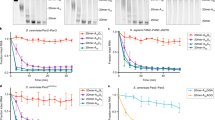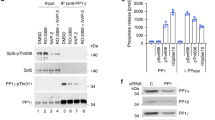Abstract
POLYADENYLATION of messenger RNA precursors is a complex process that requires multiple protein factors (for reviews, see refs 1, 2). Cleavage stimulation factor (CstF) is one of these, function-ing together with cleavage-polyadenylation specificity factor, two cleavage factors, and poly(A)+ polymerase3–7. CstF is composed of three subunits of Mr 77, 64 and 50K8,9. The 64K10 and 50K11 subunits contain, respectively, an RNP-type RNA-binding domain that contacts the pre-mRNA and transducin repeats characteristic of G-protein β-subunits. Here we report the cloning and characterization of the 77K subunit of human CstF (referred to as 77K). We show that the 77K subunit is required for formation of active CstF and bridges the 64K and 50K subunits. Sequence analyses indicate that the 77K subunit is the homologue of the protein encoded by the Drosophila melanogaster suppressor of forked (su(f)) gene12. Mutations insu(f) can enhance or suppress the effects of transposable element insertions13, and our data indicate that this is due to changes in polyadenylation. Both the 77K subunit and the su(f) protein share homology with Saccharomyces cerevisiae RNA14, previously shown to be involved in mRNA metabolism14. Our results thus also indicate that components of the complex polyadenylation machinery are conserved from yeast to man.
This is a preview of subscription content, access via your institution
Access options
Subscribe to this journal
Receive 51 print issues and online access
$199.00 per year
only $3.90 per issue
Buy this article
- Purchase on Springer Link
- Instant access to full article PDF
Prices may be subject to local taxes which are calculated during checkout
Similar content being viewed by others
References
Wahle, E. & Keller, W. A. Rev. Biochem. 61, 419–440 (1992).
Manley, J. L. & Proudfoot, N. J. Genes Dev. 8, 259–264 (1994).
Christofori, G. & Keller, W. Cell 54, 875–889 (1988).
Takagaki, Y., Ryner, L. C. & Manley, J. L. Genes Dev. 3, 1711–1724 (1989).
Gilmartin, G. M. & Nevins, J. R. Genes Dev. 3, 2180–2189 (1989).
Raabe, T., Bollum, F. J. & Manley, J. L. Nature 353, 229–234 (1991).
Wahle, E., Martin, G., Schiltz, E. & Keller, W. EMBO J. 10, 4251–4257 (1991).
Takagaki, Y., Manley, J. L., MacDonald, C. C., Wilusz, J. & Shenk, T. Genes Dev. 4, 2112–2120 (1990).
Gilmartin, G. M. & Nevins, J. R. Molec. cell. Biol. 11, 2432–2438 (1991).
Takagaki, Y., MacDonald, C. C., Shenk, T. & Manley, J. L. Proc. natn. Acad. Sci. U.S.A. 89, 1403–1407 (1992).
Takagaki, Y. & Manley, J. L. J. biol. Chem. 267, 23471–23474 (1992).
Mitchelson, A., Simonelig, M., Williams, C. & O'Hare, K. Genes Dev. 7, 241–249 (1993).
Rutledge, B. J., Mortin, M. A., Schwarz, E., Thierry-Mieg, D. & Meselson, M. Genetics 119, 391–397 (1988).
Minvielle-Sebastia, L., Winsor, B., Bonneaud, N. & Lacroute, F. Molec. cell. Biol. 11, 3075–3087 (1991).
Robbins, J., Dilworth, S. M., Laskey, R. A. & Dingwall, C. Cell 64, 615–623 (1991).
Lindsley, D. L. & Zimm, G. The Genome of Drosophila Melanogaster (Academic, San Diego, 1992).
Dorsett, D., Viglianti, G. A., Rutledge, B. J. & Meselson, M. Genes Dev. 3, 454–468 (1989).
Zachar, Z., Chou, T.-B. & Bingham, P. M. EMBO J. 6, 4105–4111 (1987).
Dudick, M. E., Wright, T. R. F. & Brothers, L. L. Genetics 76, 487–510 (1974).
Wilson, T. G. J. Embryol. exp. Morph. 55, 247–256 (1980).
Driver, A., Lacey, S. F., Cullingford, T. E., Mitchelson, A. & O'Hare, K. Molec. Gen. Genet. 220, 49–52 (1989).
Murthy, K. G. K. & Manley, J. L. J. biol. Chem. 267, 14804–14811 (1992).
Sanger, F., Nicklen, S. & Coulson, A. R. Proc. natn. Acad. Sci. U.S.A. 74, 5463–5467 (1977).
Takagaki, Y., Ryner, L. C. & Manley, J. L. Cell 52, 731–742 (1988).
Miller, D. W., Safer, P. & Miller, L. K. in Genetic Engineering vol. 8 (eds Setlow, J. K. & Hollaender, A.) 277–298 (Plenum, New York, 1986).
Field, J. et al., Molec. cell. Biol. 8, 2159–2165 (1988).
Harlow, E. & Lane, D. Antibodies: A Laboratory Manual (Cold Spring Harbor Laboratory Press, New York, 1988).
Aurora, R. & Herr, W. Molec. cell. Biol. 12, 455–467 (1992).
Han, K. & Manley, J. L. Genes Dev. 7, 491–503 (1993).
Pearson, W. R. & Lipman, D. J. Proc. natn. Acad. Sci. U.S.A. 85, 2444–2448 (1988).
Author information
Authors and Affiliations
Rights and permissions
About this article
Cite this article
Takagaki, Y., Manley, J. A polyadenylation factor subunit is the human homologue of theDrosophila suppressor of forked protein. Nature 372, 471–474 (1994). https://doi.org/10.1038/372471a0
Received:
Accepted:
Issue Date:
DOI: https://doi.org/10.1038/372471a0
This article is cited by
-
Fission yeast Ctf1, a cleavage and polyadenylation factor subunit is required for the maintenance of genomic integrity
Molecular Genetics and Genomics (2017)
-
Plant mRNA 3?-end formation
Plant Molecular Biology (1996)
Comments
By submitting a comment you agree to abide by our Terms and Community Guidelines. If you find something abusive or that does not comply with our terms or guidelines please flag it as inappropriate.



